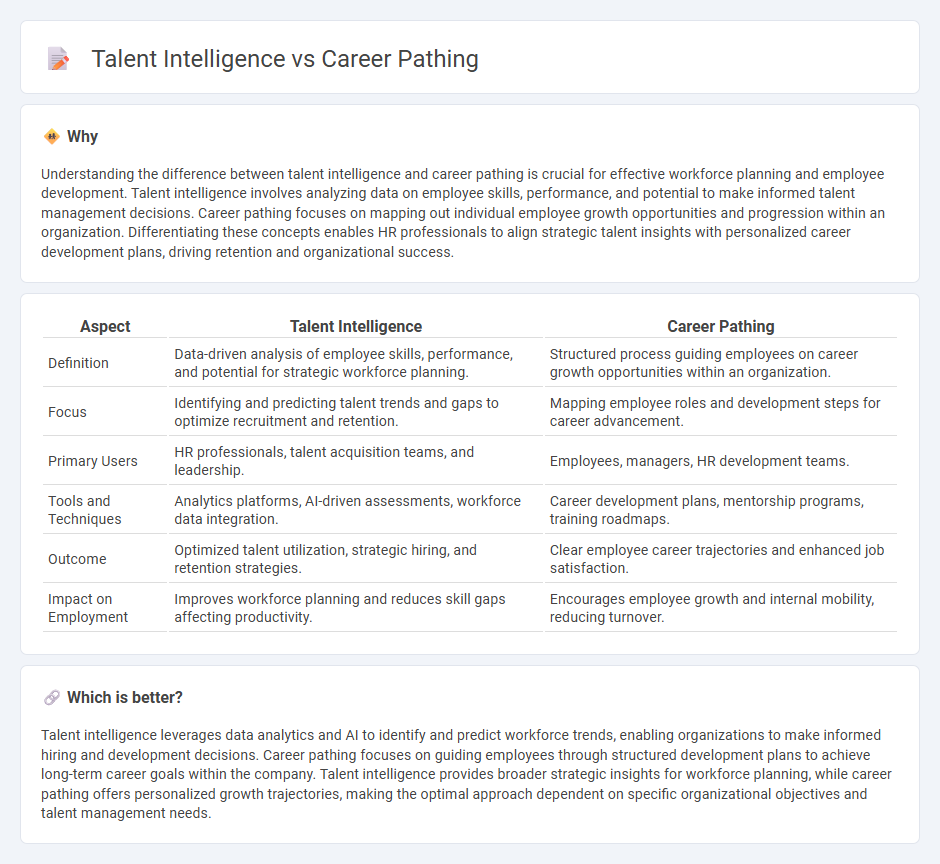
Talent intelligence leverages data analytics and AI to identify skill gaps, predict workforce trends, and match candidates to roles with precision. Career pathing focuses on mapping individual development and progression within an organization based on skills, goals, and opportunities. Discover how integrating talent intelligence with career pathing can transform employment strategies and optimize workforce potential.
Why it is important
Understanding the difference between talent intelligence and career pathing is crucial for effective workforce planning and employee development. Talent intelligence involves analyzing data on employee skills, performance, and potential to make informed talent management decisions. Career pathing focuses on mapping out individual employee growth opportunities and progression within an organization. Differentiating these concepts enables HR professionals to align strategic talent insights with personalized career development plans, driving retention and organizational success.
Comparison Table
| Aspect | Talent Intelligence | Career Pathing |
|---|---|---|
| Definition | Data-driven analysis of employee skills, performance, and potential for strategic workforce planning. | Structured process guiding employees on career growth opportunities within an organization. |
| Focus | Identifying and predicting talent trends and gaps to optimize recruitment and retention. | Mapping employee roles and development steps for career advancement. |
| Primary Users | HR professionals, talent acquisition teams, and leadership. | Employees, managers, HR development teams. |
| Tools and Techniques | Analytics platforms, AI-driven assessments, workforce data integration. | Career development plans, mentorship programs, training roadmaps. |
| Outcome | Optimized talent utilization, strategic hiring, and retention strategies. | Clear employee career trajectories and enhanced job satisfaction. |
| Impact on Employment | Improves workforce planning and reduces skill gaps affecting productivity. | Encourages employee growth and internal mobility, reducing turnover. |
Which is better?
Talent intelligence leverages data analytics and AI to identify and predict workforce trends, enabling organizations to make informed hiring and development decisions. Career pathing focuses on guiding employees through structured development plans to achieve long-term career goals within the company. Talent intelligence provides broader strategic insights for workforce planning, while career pathing offers personalized growth trajectories, making the optimal approach dependent on specific organizational objectives and talent management needs.
Connection
Talent intelligence leverages data analytics to identify skills, strengths, and growth opportunities within the workforce, enabling personalized career pathing strategies. By mapping employee competencies against organizational needs, talent intelligence helps design tailored development plans that align individual aspirations with business goals. This connection enhances employee retention, drives engagement, and optimizes workforce planning for future talent demands.
Key Terms
**Career Pathing:**
Career pathing involves mapping out a clear progression of roles and skills within an organization, helping employees understand potential future positions and the competencies needed to advance. It enhances employee engagement and retention by aligning individual goals with organizational needs through structured development plans and targeted training opportunities. Explore how career pathing can transform talent development and drive your workforce's growth.
Succession Planning
Career pathing enables organizations to map employee growth trajectories based on skills and aspirations, fostering internal mobility and leadership development. Talent intelligence leverages data analytics to identify potential successors by assessing performance metrics, competencies, and cultural fit, enhancing the precision of succession planning. Explore further to understand how integrating career pathing with talent intelligence optimizes leadership pipelines and secures organizational continuity.
Skill Development
Career pathing emphasizes structured growth by identifying key skills needed for advancement within specific roles, ensuring employees develop competencies aligned with organizational goals. Talent intelligence leverages data analytics to assess skill gaps across the workforce and predict future capability requirements, enabling strategic upskilling and reskilling initiatives. Explore how integrating career pathing with talent intelligence can optimize skill development strategies in your organization.
Source and External Links
What Is Career Pathing & Why Is It Important? - Career pathing is the process used by employers to create plans and development tracks that help employees visualize how their unique skills and interests align with career goals, mapping out growth and advancement opportunities within or beyond their current organization.
Career Pathing: The Complete Guide - Career pathing involves two main approaches: the traditional career ladder which is a linear progression, and the career lattice which allows for lateral moves and exploration in a flatter organizational structure.
Improve Employee Development with Career Pathing - Effective career pathing includes self-assessment, individual career mapping with managers, and exploring opportunities for advancement, which helps increase employee engagement and retention by providing purpose and growth.
 dowidth.com
dowidth.com